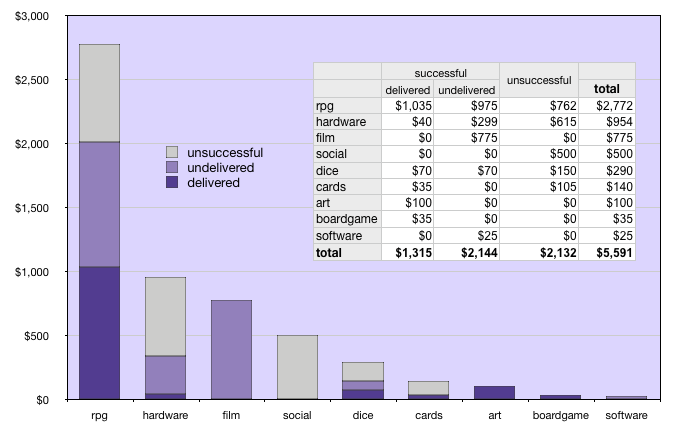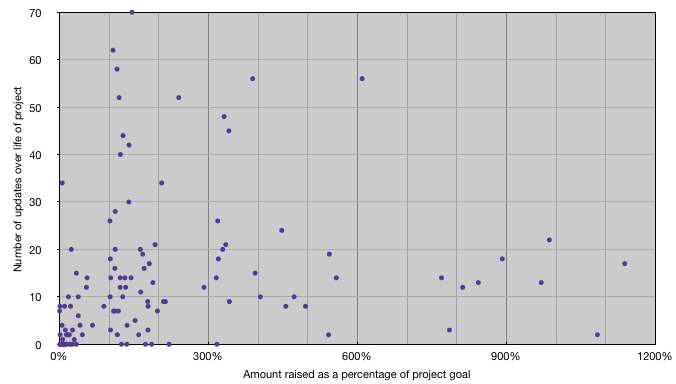DivNull Productions backs a lot of Kickstarter projects. Curious about return on investment and so on, I ran the numbers on all projects DivNull backed with a “funding complete” date prior to January 1, 2012. Thus, all projects in the data set have had at least two months to deliver goals (most have had much longer). I wanted to see how much DivNull spent, what types of projects were funded, how much money went unclaimed (i.e. projects which failed to reach their funding goal) and how many projects actually delivered. Over this period, DivNull offered funding to 113 projects, 42 of which failed to reach their funding goal. This is all summarized in the following chart.

The first take away from this graph is that the number of projects not yet delivering is higher than I would have guessed. At present, 34 of the projects DivNull funded have not delivered. The monetary value obscures this a little, as around $1500 of the total can be attributed to just four of these projects. This does, however, represent just under 48% of the funded projects, which looks grim; however, the vast majority of these projects seem to be still working towards delivery.
Another surprise is that almost half of the cash offered up didn’t get used. After funding this many projects, you get a bit of a feel for which will succeed and which won’t. Initially, DivNull was fairly promiscuous about funding, taking a “give them a chance” approach, particularly when it came to role-playing games. That trailed off slightly as time went on.
As someone who gets irritated by lots of useless project updates, I tracked how many updates were made by each project. On a whim, I created a graph of the number of updates vs. the percentage of the target funds raised by the project:

I’m not sure this reveals much of anything, except perhaps that there is no clear correlation between number of updates and funding success. And, perhaps, that overly successful projects clearly don’t update more often than other projects. I made an attempt for a while to categorize the type of comments made and count them, but ran out of interest so my dataset is incomplete. The categories may be of interest, though, especially in that they can be divided into two groups based on category: comments I care about and comments I don’t care about. All comments fell into one of these categories:
- “Spread the word”: requests for backers to shill for the project.
- “Project is progressing”: essentially a progress report without offering any new content.
- “Nothing is happening”: a non-progress report, usually to reassure backers that the project is still alive, even though it’s not being worked on.
- “Success/thanks”: Nearly every project has at least one “we did it” post.
- “Explaining delay or problem”: Details about why you’re not getting your swag on time.
- “Pitch changes/clarifications”: Adding new tiers, bonus goals provided in the event of overfunding, etc.
- “Pitch of related Kickstarter”: If you liked this project, you might like…
- “Art/content preview”: Preview text or artwork, all by itself. Sometimes art is included with other sorts of updates.
- “Reference to external content”: Links to a forum or blog supporting the project. Sometimes links to freebie stuff supporting the product, such as character sheets.
- “Incremental version”: Download to beta drafts, etc.
- “Request for information”: Project needs to give them information.
- “Release details”: Links to PDFs, details of product shipping, etc.
This list is sorted in order of least important to me to most important to me. Generally, I really only must see the last two.